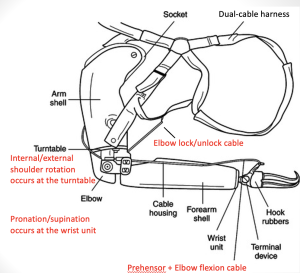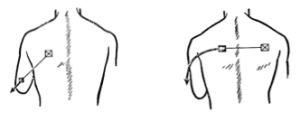15 Transhumeral Suspension and Control
In transhumeral limb loss the functions of the hand, wrist, and elbow are absent, but those of the shoulder and residual limb remain. The transhumeral prosthesis must provide substitutes for the missing functions. To accomplish this, the transhumeral harness must transmit power to flex the prosthetic forearm, to lock and unlock the elbow unit, and to operate the terminal device.

The fully body-powered transhumeral prosthesis operates through the use of a dual-cable harness. The two separate cables are the fairlead cable and the elbow lock cable.
| Cable | Fairlead cable | Elbow Lock Cable |
| Component operation | TD operation and elbow flexion | Elbow lock/unlock |
| Body movement | Arm flexion and scapular abduction | Arm extension, shoulder depression and arm abduction |
The elbow-lock cable is a bowden cable which extends from the elbow lock control strap to the locking mechanism in the elbow joint. When pulled and released, it operates one component: the elbow lock.
- Glenohumeral extension, shoulder depression and arm abduction operates one component: the elbow lock.
- To lock the elbow, the patient simultaneously depresses, extends, and abducts the shoulder. The contralateral shoulder must remain stabilized. This small but complex movement increases the distance between the elbow locking lever and the cable anchor point. The resulting relative motion between the locking lever and control cable anchor point activates the lock. A well-trained patient performs this elbow lock control movement almost imperceptibly. Nevertheless, this control remains the most difficult to master.
The fairlead cable (aka, dual-control cable, split-housing cable) extends from the control strap to the TD. When pulled, it operates two components (i.e., dual-control): elbow flexion and TD opening.
- Glenohumeral flexion operates two components: elbow flexion and TD operation
- When the forearm is extended and the elbow unlocked, flexing the ipsilateral shoulder transmits force to the lift tab, flexing the elbow unit. The force is also transmitted to the TD operating lever, but the latter does not operate, since the amount of force required to operate the VO TD is greater than that needed to flex the forearm.
- Once the elbow is locked, force is again transmitted through the fairlead cable but now the force and excursion pull on the TD operating lever.
- Setup: The fairlead cable is guided by two separate lengths of housing (i.e., split-housing). The lengths of housing are fastened to the prosthesis with two fairleads at points where the cable must be supported or operated through an angle. When force is transmitted through the housing and cable, side forces are exerted on the fairleads where the cable bends through an angle. The fact that these forces are exerted where the cable operated through an angle is used as an advantage in the transhumeral dual-control system. With the forearm adjusted in 10 degrees of initial elbow flexion (i.e., it’s maximum extension is 10 degrees short of full extension), the control cable causes a force to be exerted on the lever loop to flex the forearm.
Usefulness of a body-powered is dependent on an individual’s ability to capture excursion, generate force to operate the components and pre-position the TD in space.
- The dual-control cable must be aligned accurately to capture livelift.
- The amount of force required to operate the VO TD must be greater than that needed to flex the forearm.
- Fflex elbow <<< FcloseVO TD
- The dual-control cable setup relies on livelift. This setup limits the maximum force and therefore ability to handle many objects. In most cases the person flexes the forearm to the position desired, locks the elbow, then grasps the object to be lifted.[1]
“Excursion” can be interpreted differently:
- Excursion generated by the body: capacity of body to generate movement (control motion)
- Excursion captured by the prosthesis through the harness (some control motion excursion is lost, e.g., sliding on the NW ring or sinking into soft tissue)
- Excursion required to control the components (aka operational or displacement)
| Control Motion | Force (lbs) | Excursion (inches) |
| Glenohumeral flexion | 56 lbs | 5.3” |
| Biscapular abduction | 49 lbs | 1.6” |
| Shoulder depression | 44 lbs | 1.1” |
| Operation | Force (lbs) | Displacement (inches) |
| Forearm flexion (no load on hook) | 9 | 2-2.5 |
| Prehension, VC hook | 9-35 | 1.5 |
| Prehension, VO hook | 10-20 | 1.5 |
| Elbow lock | 2-4 | 0.6 |
| Upper Limb Prosthetics, Prosthetist’s Supplement, New York University Medical Center |
Body-powered Harness Questions
- The control attachment strap ideally lies over the lower third of the scapula in order to capture as much excursion as possible. What happens when the base plate is moved proximally with a shorter residual limb?
- With the fairlead cable, you need 2-2.5″ of excursion to fully flex the elbow unit and about 1.5″ to open the VO TD. With short transhumeral residual limbs, patients have difficulty generating excursion. What do you need to do to increase the excursion to enhance operation of the cabling system?
- The fairlead cable system is dependent on livelift. If the TD is opening before the elbow is flexing, what can you do to improve live lift?
- Fflex elbow <<< FcloseVO TD
- What can you do to increase the F to open the TD
- What can you do to decrease the F to flex the elbow?
- The images below illustrate the location and path of the cable. The left images shows the path between the scapula and humerus (glenohumeral motion) and the right image shows the path between the left and right sides of the spine (protraction motion).
- Which of the images show the path to capture more excursion?
- Which of the images show the path to capture more force?

- New York University, Upper Limb Prosthetics, 1979 revision ↵
The Elbow Flexion/TD Control Cable is one cable that operates the TD and elbow flexion. This cable can be called the fair-lead cable, split cable or dual control cable.
A fairlead is a device that guides a line, rope, or cable around an object or structure
The ability to flex the elbow while holding something in the TD.
